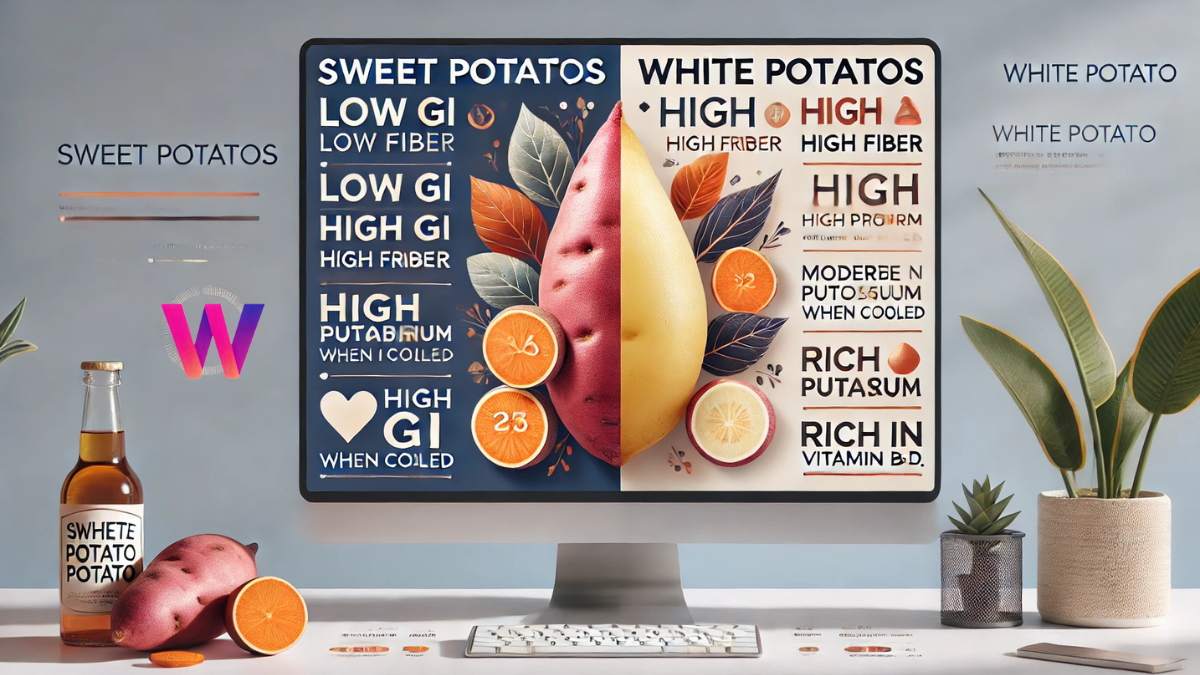Potatoes are enjoyed globally in various forms—boiled, baked, roasted, or fried. For individuals managing diabetes, incorporating starchy foods like potatoes can be challenging. Understanding the relationship between carbohydrates, blood sugar levels, and the glycemic index (GI) is essential for making informed dietary decisions. The question “can diabetics eat potatoes?” often arises, with sweet potatoes frequently recommended for their higher nutrient density and lower GI compared to white potatoes. But does that mean white potatoes should be off-limits? This discussion delves into the nutritional distinctions, effects on blood sugar, and how diabetics can include these root vegetables in a balanced diet.
Nutritional Breakdown of Sweet Potatoes vs. White Potatoes
1. Macronutrient Comparison
Sweet potatoes and white potatoes are closer in nutritional profile than many might assume. Here is a comparative snapshot per 100-gram serving:
- Sweet Potatoes: ~86 calories, 20 grams of carbohydrates, 3 grams of fiber, 4 grams of sugar, rich in beta-carotene (Vitamin A precursor), and substantial Vitamin C and potassium[1].
- White Potatoes: ~93 calories, 21 grams of carbohydrates, 2 grams of fiber, 1 gram of sugar, higher in potassium and Vitamin B6.
Sweet potatoes are distinct for their high beta-carotene content, particularly orange-fleshed varieties, providing over 100% of the recommended daily intake of Vitamin A per serving. This antioxidant plays a role in vision health and immune function. White potatoes, on the other hand, are richer in potassium, important for regulating blood pressure.
2. Carbohydrates and Fiber Content
Carbohydrates are a primary concern for diabetics, as they directly affect blood sugar levels. Sweet potatoes offer slightly more fiber per serving, which can slow down the absorption of sugars, thereby reducing the likelihood of blood sugar spikes. Fiber also supports digestive health and prolongs satiety, making it a valuable nutrient for weight managemen.
Takeaway: Both potatoes offer important nutrients, but sweet potatoes’ additional fiber and high antioxidant content give them a marginal edge for diabetics when consumed in moderation.
Glycemic Index and Load: Key Differences
The glycemic index (GI) measures how fast a carbohydrate-containing food raises blood glucose levels. Foods are categorized as low (GI ≤ 55), medium (56-69), or high (≥ 70).
Glycemic Index of Sweet Potatoes
- Boiled: GI of 44-46 (low), making it a suitable option for diabetics.
- Baked/Roasted: GI above 70, placing it in the high-GI category.
Boiling sweet potatoes retains resistant starch, which slows digestion and helps prevent rapid spikes in blood sugar.
Glycemic Index of White Potatoes
- Boiled: GI typically around 50-60, with some specific varieties (e.g., Carisma) having a GI as low as 38.
- Baked/Roasted: GI can range from 70-90, much higher than their boiled counterparts.
- Chilled and Served Cold: Cooking, cooling, and consuming white potatoes cold significantly reduces their GI due to increased resistant starch.
What This Means for Diabetics:
- Preparation methods are critical for both types of potatoes.
- Boiling is the best method to retain a lower GI in sweet potatoes and is also helpful for reducing GI in white potatoes.
- Cooling white potatoes after boiling can further reduce the GI, offering an alternative method to enjoy them with minimal blood sugar impact.
Cooking Techniques and Diabetes-Friendly Tips
Best Cooking Methods
- Boiling: Maintains lower GI levels, making boiled potatoes a healthier choice for diabetics.
- Baking/Roasting: This method raises the GI of both white and sweet potatoes. To minimize the impact, try pairing roasted potatoes with high-fiber vegetables or protein.
- Frying: Should be avoided due to added fats and a high GI impact.
How to Balance Potato Dishes for Blood Sugar Control
- Portion Control: Limit to a 1/3 or 1/2 cup serving of potatoes to prevent excessive carb intake.
- Pairing with Protein: Combining potatoes with lean protein and non-starchy vegetables can moderate blood sugar rises.
- Incorporating Healthy Fats: Add a drizzle of olive oil or nuts for better satiety and blood sugar management.
- Acidic Foods: Foods like lemon juice or vinegar can help slow down the conversion of starch to sugar.
Sample Meals:
- Breakfast Bowl: Top a boiled, cooled, and diced sweet potato with scrambled eggs and sautéed spinach.
- Lunch Salad: Use cold, boiled white potatoes with mixed greens, grilled chicken, and a vinaigrette dressing.
- Dinner Side: Serve a baked sweet potato alongside roasted salmon and steamed broccoli.
Health Benefits Beyond Blood Sugar Management
Sweet Potatoes
- Antioxidants: High in beta-carotene (orange varieties), anthocyanins (purple varieties), and phenolic acids, which may reduce inflammation and improve insulin sensitivity.
- Immune System Support: Rich in vitamins C and A, beneficial for immune function.
White Potatoes
- Potassium-Rich: Helps in blood pressure regulation and muscle function.
- Satiety Factor: Potatoes are naturally satiating, which can aid in weight control if consumed with care.
Considerations for Special Varieties
Purple sweet potatoes have higher concentrations of antioxidants like anthocyanins, which may offer additional health benefits, such as improved insulin sensitivity and reduced inflammation.
Conclusion:
For diabetics, both sweet potatoes and white potatoes can be part of a balanced diet with careful planning and moderation. Sweet potatoes offer a slight nutritional edge, especially when boiled, but white potatoes can still be a diabetes-friendly option when prepared correctly. The keys to enjoying potatoes without compromising blood sugar control include proper portion sizes, mindful preparation methods, and pairing with other low-GI foods.
Final Takeaway: Moderation, mindful cooking methods, and balanced meals are essential. Potatoes can be part of your diabetes management plan when enjoyed thoughtfully. As always, consult with a healthcare provider or dietitian to tailor your diet to your specific needs.
